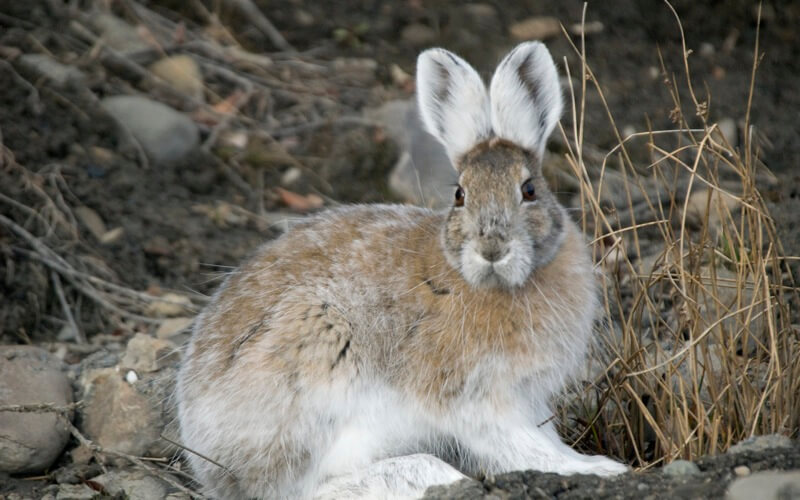Snowshoe Hares, Seasonal Camouflage, and the Consequences of Transitioning Too Early
by Rachael Cheff
Broadcast 12.2021 & 12.13 & 12.16.2023

Snowshoe hare in the midst of transitioning from summer brown to winter white. Photo by D. Sikes, CC 2.0.
Listen:
Part of the joy in living in Montana comes from the distinct seasons we enjoy here. From the soft rains of spring, to the intense summer sun, the brilliant transition that is autumn down to winter’s chill. As I write, this winter’s first major snowfall blankets the ground outside. Though it’s still a bit early for winter, mentally I begin to prepare myself for the cold months ahead. Living in this region is about anticipating change.
Even my house cat, currently at the window watching marble-sized snowflakes hurtling towards the earth, feels this change. She rests indoors all day, and still her fur has grown thicker in anticipation of the cold to come.
The change in my cat’s fur reminds me of a larger-scale transition undergone by the snowshoe hare. This hare sheds her brown summer coat at the end of autumn while growing new fur that is not only thicker, but another color altogether to help stay aligned with the change in seasons. Rather than shed her fur all at once, the actual process happens in sections. Her feet and head will begin sprouting white furs in her brown coat first, and this pale fur will steadily creep down her back before spreading outward, until everything but part of her ears and her dark eyes are snow white.
The evolutionary advantage is clear—in the warmer months, her brown fur helps her camouflage with the dirt and the brush, while her thicker white coat warms her and helps her blend in with the snow she is named for. But what actually causes this change? Does she begin to shed one fur for another once the winter chill settles in? Does she begin the process when she notices sunlight disappears earlier in the day? Does it matter what specifically causes the change so long as she wears the appropriate camouflage?
Some research into these questions shows they’re on the minds of scientists too, particularly when it comes to how climate change affects how the snowshoe hares and other animals maintain their seasonal camouflage. Changing climate has led to unpredictable weather and erratic snow cycles. A study conducted at the University of Montana examined how snow falling later than expected and melting earlier may affect snowshoe hares. The team equipped snowshoe hares with radio collars to track the progression of their seasonal molt, and to note whether or not the hares were still alive each time the team collected new data.
The first thing the team noticed was that the snowshoe hares operate individually when it comes to changing their coat, meaning a snowshoe hare can begin the transition long before her next door neighbor does. They also saw that because the hares’ fur transitions a little bit at a time, the hares were bound to be at least partially mismatched with the current season at some point during the change, making them more noticeable to predators.
The team quantified the degree of mismatch based on how far along the hare’s fur transition was related to the change in seasons. This meant that a hare that was exactly halfway through her molt before snow had fallen would be 50 percent mismatched. They then took these numbers and analyzed how having an off-season coat affected the likelihood that the hares, sometimes fully snow white and attempting to camouflage with brown earth, would become a meal for a predator between the team’s checkups.
The team found that the prompt that traditionally allowed the snowshoe hares to complete their transition exactly in time with snowfall and snowmelt may no longer be faithful to seasons affected by changing climate. As a result, snowshoe hares are beginning the transition too early for snowfall, or too late for snowmelt. Their off-season apparel, while beneficial when worn in the appropriate time of year, could be the beacon that alerts predators to their location when worn at the wrong time. The team theorized that if the weather continues to be unpredictable, only evolutionary-level change to the coat-changing process can help snowshoe hares, on which so many other animals depend, survive.
Personally safe from existential concerns about predators and camouflage (yet thinking of them nonetheless), my cat and I continue to watch the snow fall outside, which looks as though it will continue to fall long after I’ve gone to bed. I wonder if this snow will melt soon or if it is here to stay. I hope the snowshoe hares are prepared.
Every week since 1991, Field Notes has inquired about Montana’s natural history. Field Notes are written by naturalists, students, and listeners about the puzzle-tree bark, eagle talons, woolly aphids, and giant puffballs of Western, Central and Southwestern Montana and aired weekly on Montana Public Radio.
Click here to read and listen to more Field Notes. Field Notes is available as a podcast! Subscribe on Apple Podcasts or wherever you listen to podcasts.
Interested in writing a Field Note? Contact Allison De Jong, Field Notes editor, at adejong [at] montananaturalist [dot] org or 406.327.0405.
Want to learn more about our programs as well as fun natural history facts and seasonal phenology? Sign up for our e-newsletter! You can also become a member and get discounts on our programs as well as free reciprocal admission to 300+ science centers in North America!












